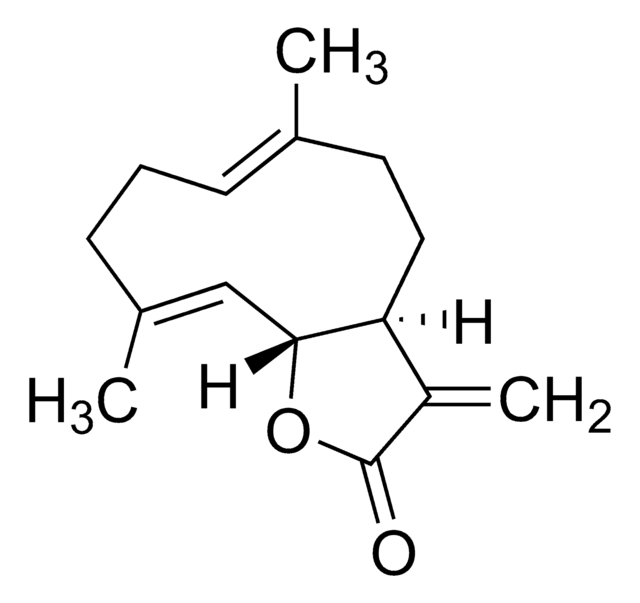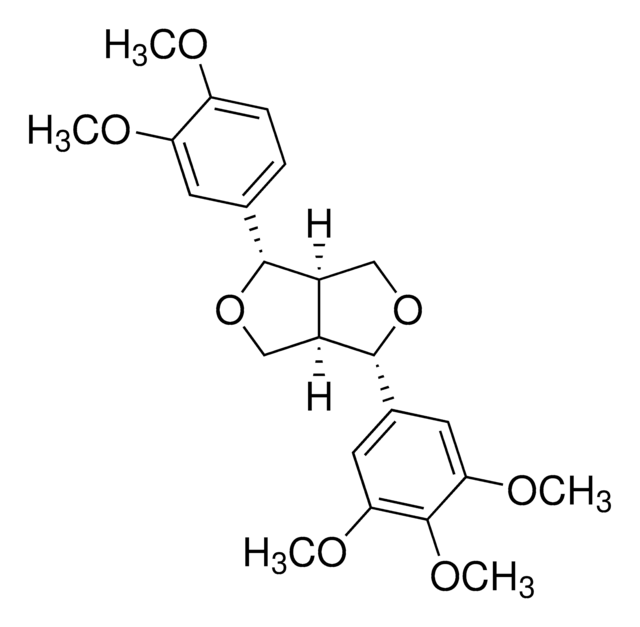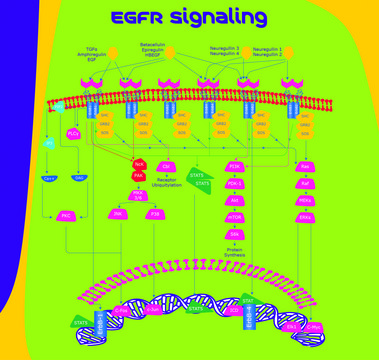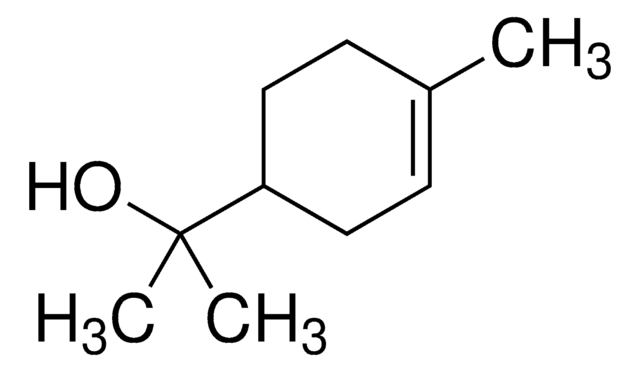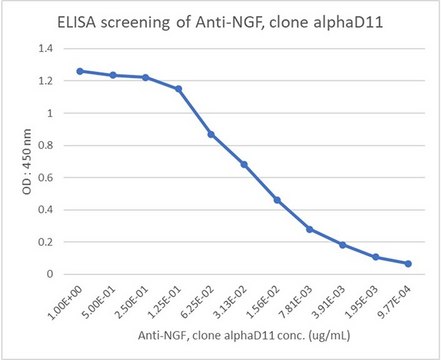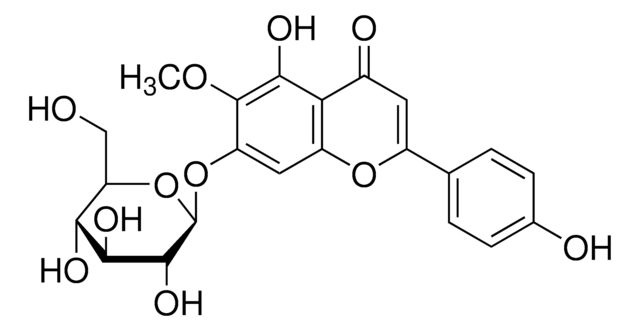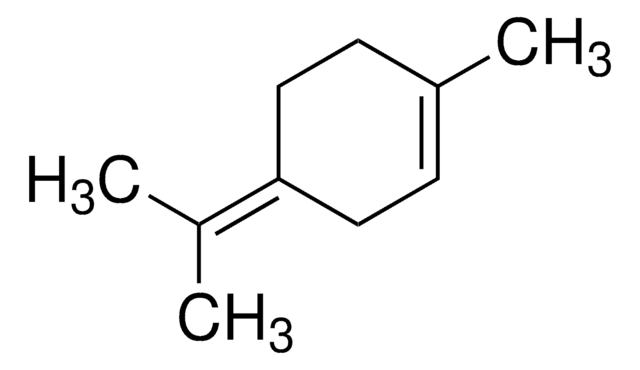MAB5260Z
Anti-Nerve Growth Factor Antibody, clone 27/21, azide free
clone 27/21, Chemicon®, from mouse
Sign Into View Organizational & Contract Pricing
All Photos(1)
Synonym(s):
NGF, MAB5260
UNSPSC Code:
12352203
eCl@ss:
32160702
NACRES:
NA.41
Recommended Products
biological source
mouse
Quality Level
antibody form
purified immunoglobulin
antibody product type
primary antibodies
clone
27/21, monoclonal
species reactivity
human, rat, bovine, mouse
packaging
antibody small pack of 25 μg
manufacturer/tradename
Chemicon®
technique(s)
ELISA: suitable
neutralization: suitable
isotype
IgG1
NCBI accession no.
UniProt accession no.
shipped in
wet ice
target post-translational modification
unmodified
Gene Information
human ... NTF3(4908)
Related Categories
Specificity
Specifically reacts with the beta -subunit of NGF from mouse, in the 2.5S- as well as in the 7S-form.
Immunogen
2.5 S form of mouse NGF.
Application
Detect Nerve Growth Factor using this Anti-Nerve Growth Factor Antibody, clone 27/21, azide free validated for use in ELISA, NEUT.
Research Category
Neuroscience
Neuroscience
Research Sub Category
Neurochemistry & Neurotrophins
Neurochemistry & Neurotrophins
The antibody is used for the neutralization of NGF in cell culture systems. Furthermore the antibody is used to immunosympathectomy.
Optimal working dilutions must be determined by end user.
Optimal working dilutions must be determined by end user.
Linkage
Replaces: 04-1119
Physical form
Format: Purified
Protein A Purified mouse immunoglobulin in 20 mM sodium phosphate, 250 mM NaCl, pH. 7.6, with no preservatives.
Protein A purified
Storage and Stability
Maintain for 6 months at 2–8°C from date of shipment. Aliquot to avoid repeated freezing and thawing. For maximum recovery of product, centrifuge the original vial after thawing and prior to removing the cap.
Analysis Note
Control
Brain tissue
Brain tissue
Other Notes
Concentration: Please refer to the Certificate of Analysis for the lot-specific concentration.
Legal Information
CHEMICON is a registered trademark of Merck KGaA, Darmstadt, Germany
Disclaimer
Unless otherwise stated in our catalog or other company documentation accompanying the product(s), our products are intended for research use only and are not to be used for any other purpose, which includes but is not limited to, unauthorized commercial uses, in vitro diagnostic uses, ex vivo or in vivo therapeutic uses or any type of consumption or application to humans or animals.
WGK
WGK 2
Flash Point(F)
Not applicable
Flash Point(C)
Not applicable
Certificates of Analysis (COA)
Search for Certificates of Analysis (COA) by entering the products Lot/Batch Number. Lot and Batch Numbers can be found on a product’s label following the words ‘Lot’ or ‘Batch’.
Already Own This Product?
Find documentation for the products that you have recently purchased in the Document Library.
Large-scale production of dsRNA and siRNA pools for RNA interference utilizing bacteriophage phi6 RNA-dependent RNA polymerase.
Aalto, AP; Sarin, LP; van Dijk, AA; Saarma, M; Poranen, MM; Arumae, U; Bamford, DH
RNA null
Mikk Raba et al.
Frontiers in cellular neuroscience, 10, 66-66 (2016-03-26)
Postnatal maturation of the neurons whose main phenotype and basic synaptic contacts are already established includes neuronal growth, refinement of synaptic contacts, final steps of differentiation, programmed cell death period (PCD) etc. In the sympathetic neurons, postnatal maturation includes permanent
Patricia Cassina et al.
Journal of neurochemistry, 93(1), 38-46 (2005-03-19)
Fibroblast growth factor-1 (FGF1 or acidic FGF) is highly expressed in motor neurons. FGF-1 is released from cells by oxidative stress, which might occur from SOD-1 aberrant function in amyotrophic lateral sclerosis (ALS). Although FGF-1 is known to be neuroprotective
E Stener-Victorin et al.
Obesity science & practice, 2(4), 426-435 (2017-01-17)
Insulin sensitivity is ~40% lower in women with polycystic ovary syndrome (PCOS) than in controls. We tested the hypothesis that 5 weeks of electroacupuncture treatment improves glucose regulation and androgen levels in overweight/obese women with PCOS. Seventeen women with PCOS, aged
M Jakobson et al.
Cell death & disease, 4, e777-e777 (2013-08-24)
N-Bak is a neuron-specific BH3-only splice variant of pro-apoptotic Bcl-2 family member Bak. We have shown that its mRNA is stable in the neurons, whereas the protein cannot be detected by antibodies, suggesting a strong translational arrest of the mRNA.
Our team of scientists has experience in all areas of research including Life Science, Material Science, Chemical Synthesis, Chromatography, Analytical and many others.
Contact Technical Service